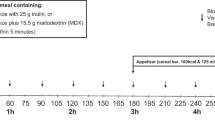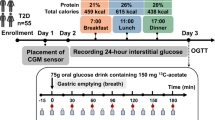Abstract
Backgroud/Objective:
To compare postprandial responses elicited by sucromalt, a nutritive sweetener produced by treating a blend of sucrose and corn syrup with an enzyme from Leuconostoc mesenteroides, with those after 42% of high-fructose corn syrup (HFCS), and to see if the reduced responses after sucromalt could be accounted for by carbohydrate malabsorption.
Subject and Methods:
Three experiments were performed in separate groups of normal subjects studied after overnight fasts using double-blind, randomized, cross-over designs. HFCS was used as the control because it contained a similar amount of fructose as sucromalt. Experiment 1 (n=10): plasma glucose and insulin were measured after 50 g sucromalt and 50 g HFCS. Experiment 2 (n=10): metabolic profiles were measured after 80 g HFCS, 80 g sucromalt or 56 g fructose/glucose blend plus 24 g inulin. Experiment 3 (n=20): the glycaemic indices of sucromalt and HFCS were determined.
Results:
Mean glucose and insulin responses after sucromalt were 66 and 62%, respectively, of those after HFCS (P<0.05). The inulin treatment, used to mimic the effects of carbohydrate malabsorption, elicited higher breath hydrogen (H2), lower glucose and insulin responses, and a significantly earlier rise in serum free fatty acids (FFA) than those of HFCS (all P<0.05). Sucromalt elicited no rise in breath H2, and delayed falls in glucose and insulin, and a delayed rebound of FFA compared to HFCS (all P<0.05).
Conclusions:
The reduced glucose and insulin responses elicited by sucromalt are not explained by malabsorption and are more likely related to differences in either rate of digestion and absorption or postabsorptive handling by body.
This is a preview of subscription content, access via your institution
Access options
Subscribe to this journal
Receive 12 print issues and online access
$259.00 per year
only $21.58 per issue
Buy this article
- Purchase on Springer Link
- Instant access to full article PDF
Prices may be subject to local taxes which are calculated during checkout




Similar content being viewed by others
References
Bell SJ, Sears B (2003). Low-glycemic-load diets: impact on obesity and chronic diseases. Crit Rev Food Sci Nutr 43, 357–377.
Brighenti F, Benini L, Del Rio D, Casiraghi C, Pellegrini N, Scazzina F et al. (2006). Colonic fermentation of indigestible carbohydrates contributes to the second-meal effect. Am J Clin Nutr 83, 817–822.
Brouns F, Bjorck I, Frayn KN, Gibbs AL, Lang V, Slama G et al. (2005). Glycaemic index methodology. Nutr Res Rev 18, 145–171.
Brubaker PL (1991). Regulation of intestinal proglucagon-derived peptide secretion by intestinal regulatory peptides. Endocrinology 128, 3175–3182.
Chen M, Porte D (1975). The effect of rate and dose of glucose infusion on the acute insulin response in man. J Clin Endocrinol Metab 42, 1168–1175.
Christensen NJ, Ørskov H, Hansen AP (1972). Significance of glucose load in oral glucose tolerance tests. Acta Med Scand 192, 337–342.
Cody RP, Smith JK (1997). Applied Statistics and the SAS Programming Language 4th edn Prentice-Hall: Upper Saddle River, NJ, USA.
Collier GR, Wolever TMS, Jenkins DJA (1987). Concurrent ingestion of fat and reduction in starch content impairs carbohydrate tolerance to subsequent meals. Am J Clin Nutr 45, 963–969.
Daly ME, Vale C, Walker M, Littlefield A, Alberti KGMM, Mathers J (2000). Acute fuel selection in response to high-sucrose and high-starch meals in healthy men. Am J Clin Nutr 71, 1516–1524.
Foster-Powell K, Holt SH, Brand-Miller JC (2002). International table of glycemic index and glycemic load values: 2002. Am J Clin Nutr 76, 5–56.
Frost G, Brynes A, Leeds A (1999). Effect of large bowel fermentation on insulin, glucose, free fatty acids, and glucagons-like peptide-1 (7–36) amide in patients with coronary heart disease. Nutrition 15, 183–188.
Gee JM, Johnson IT (2005). Dietary lactitol fermentation increases circulating peptide YY and glucagon-like peptide-1 in rats and humans. Nutr 21, 1036–1043.
Jenkins DJA, Mayer A, Jenkins AL, Wolever TMS, Collier GR, Wesson V et al. (1987). Simple and complex carbohydrates: lack of glycemic difference between glucose and glucose polymers. J Clin Nutr Gastroenterol 2, 113–116.
Jenkins DJA, Wolever TMS, Ocana AM, Vuksan V, Cunnane SC, Jenkins M et al. (1990). Metabolic effects of reducing rate of glucose ingestion by single bolus versus continuous sipping. Diabetes 39, 775–781.
Jenkins DJA, Wolever TMS, Taylor RH, Barker HM, Fielden H, Baldwin JM et al. (1981). Glycemic index of foods: a physiological basis for carbohydrate exchange. Am J Clin Nutr 34, 362–366.
Jenkins DJA, Wolever TMS, Taylor RH, Griffiths C, Krzeminska K, Lawrie JA et al. (1982). Slow release carbohydrate improves second meal tolerance. Am J Clin Nutr 35, 1339–1346.
Juntunen KS, Laaksonen DE, Autio K, Niskanen LK, Holst JJ, Savolainen KE et al. (2003). Structural differences between rye and wheat breads but not total fiber content may explain the lower postprandial insulin response to rye bread. Am J Clin Nutr 78, 957–964.
Kendall CW, Emam A, Augustin LS, Jenkins DJ (2004). Resistant starches and health. J AOAC Int 87, 769–774.
Krause HP, Keup U, Puls W (1982). Inhibition of disaccharide digestion in rat intestine by the alpha-glucosidase inhibitor acarbose (BAY g 5421). Digestion 23, 232–238.
Lang V, Bornet FRJ, Vaugelade P, van Ypersele de Strihou M, Luo J et al. (1999). Euglycemic hyperinsulinemic clamp to assess posthepatic glucose appearance after carbohydrate loading. 2. Evaluation of corn and mung bean starches in healthy men. Am J Clin Nutr 69, 1183–1188.
Liljeberg HGM, Åkerberg AKE, Björck IME (1999). Effect of the glycemic index and content of indigestible carbohydrates of cereal-based breakfast meals on glucose tolerance at lunch in healthy subjects. Am J Clin Nutr 69, 647–655.
Livesey G (2003). Health potential of polyols as sugar replacers, with emphasis on low glycaemic properties. Nutr Res Rev 16, 163–191.
Probert HM, Gibson GR (2002). Investigating the prebiotic and gas-generating effects of selected carbohydrates on the human colonic microflora. Lett Appl Microbiol 35, 473–480.
Ranganath L, Morgan L (2000). An osmotic stimulus-mediating glucagon-like peptide-1 (7–36 amide) (GLP-1) secretion in acarbose-induced sucrose malabsorption? Nutrition 16, 64–66.
Reimer RA, McBurney MI (1996). Dietary fiber modulates intestinal proglucagon messenger ribonucleic acid and postprandial secretion of glucagon-like peptide-1 and insulin in rats. Endocrinology 137, 3948–3956.
Roberfroid MB (2005). Introducing inulin-type fructans. Br J Nutr 93 (Suppl 1), S13–S25.
Roberge JN, Brubaker PL (1991). Secretion of proglucagon-derived peptides in response to intestinal luminal nutrients. Endocrinology 128, 3169–3174.
Rumessen JJ, Gudmand-Høyer E (1998). Fructans of chicory: intestinal transport and fermentation of different chain lengths and relation to fructose and sorbitol malabsorption. Am J Clin Nutr 68, 357–364.
Sanz ML, Côté GL, Gibson GR, Rastall RA (2006). Influence of glycosidic linkages and molecular weight on the fermentation of maltose-based oligosaccharides by human gut bacteria. J Agric Food Chem 54, 9779–9784.
Sanz ML, Gibson GR, Rastall RA (2005). Influence of disaccharide structure on prebiotic selectivity in vitro. J Agric Food Chem 53, 5192–5199.
van den Heuvel EGHM, Wils D, Pasman WJ, Bakker M, Saniez M-H, Kardinaal AFM (2004). Short-term digestive tolerance of different doses of Nutriose®FB, a food dextrin, in adult men. Eur J Clin Nutr 58, 1046–1055.
van den Heuvel EGHM, Wils D, Pasman WJ, Saniez MH, Kardinaal AFM (2005). Dietary supplementation of different doses of Nutriose®FB, a fermentable dextrin, alters the activity of faecal enzymes in healthy men. Eur J Nutr 44, 445–451.
Vogt JA, Pencharz PB, Wolever TMS (2004). -rhamnose raises serum propionate in humans. Am J Clin Nutr 80, 89–94.
Wahlqvist ML, Wilmshurst EG, Murton CR, Richardson EN (1978). The effect of chain length on glucose absorption and the related metabolic response. Am J Clin Nutr 31, 1998–2001.
Wolever TMS (2004). Carbohydrate and the regulation of blood glucose and metabolism. Nutr Rev 61, S40–S48.
Wolever TMS (2006). The Glycaemic Index: A Physiological Classification of Dietary Carbohydrate. CABI Publishing: Wallingford, UK.
Wolever TMS, Bentum-Williams A (1994). Effect of fixed versus weight-adjusted dose of oral glucose on plasma glucose, insulin and FFA responses; implications for the design of postprandial studies. Nutr Res 14, 799–806.
Wolever TMS, Bolognesi C (1996a). Source and amount of carbohydrate affect postprandial glucose and insulin in normal subjects. J Nutr 126, 2798–2806.
Wolever TMS, Bolognesi C (1996b). Prediction of glucose and insulin responses of normal subjects after consuming mixed meals varying in energy, protein, fat, carbohydrate and glycemic index. J Nutr 126, 2807–2812.
Wolever TMS, Bentum-Williams A, Jenkins DJA (1995). Physiologic modulation of plasma FFA concentrations by diet: metabolic implications in non-diabetic subjects. Diabetes Care 18, 962–970.
Wolever TMS, Spadafora P, Eshuis H (1991). Interaction between colonic acetate and propionate in man. Am J Clin Nutr 53, 681–687.
Wolever TMS, Yang M, Zeng XY, Atkinson F, Brand-Miller JC (2006). Food glycemic index, as given in GI tables, is a significant determinant of glycemic responses elicited by composite breakfasts. Am J Clin Nutr 83, 1306–1312.
Zar JH (1984). Biostatistical Analysis 2nd edn Prentice-Hall: Englewood Cliffs, NJ, USA.
Acknowledgements
Supported by Cargill Inc. TC is employed by Cargill Inc. TMSW received a research grant from Cargill and is President and part-owner of Glycemic Index Laboratories Inc. and Glycaemic Index Testing Inc. AG declares no conflict of interest.
Author information
Authors and Affiliations
Corresponding author
Additional information
The study was conceived by TC and TMSW with all authors contributing equally to the final design, statistical analysis and interpretation of the results. AG collected the data for experiment 2 and wrote the first draft of the manuscript that was edited by TMSW and reviewed by AG and TC.
Rights and permissions
About this article
Cite this article
Grysman, A., Carlson, T. & Wolever, T. Effects of sucromalt on postprandial responses in human subjects. Eur J Clin Nutr 62, 1364–1371 (2008). https://doi.org/10.1038/sj.ejcn.1602890
Received:
Revised:
Accepted:
Published:
Issue Date:
DOI: https://doi.org/10.1038/sj.ejcn.1602890
Keywords
This article is cited by
-
Activation of gastrointestinal ileal brake response with dietary slowly digestible carbohydrates, with no observed effect on subjective appetite, in an acute randomized, double-blind, crossover trial
European Journal of Nutrition (2022)
-
Replacement of glycaemic carbohydrates by inulin-type fructans from chicory (oligofructose, inulin) reduces the postprandial blood glucose and insulin response to foods: report of two double-blind, randomized, controlled trials
European Journal of Nutrition (2018)
-
A systematic review on the effect of sweeteners on glycemic response and clinically relevant outcomes
BMC Medicine (2011)



